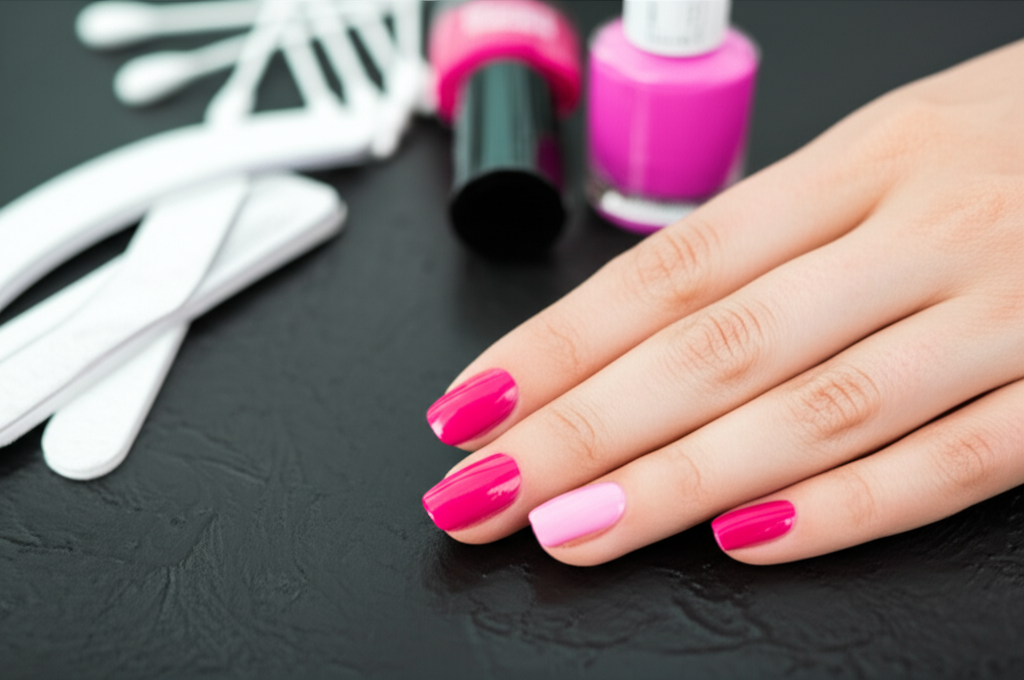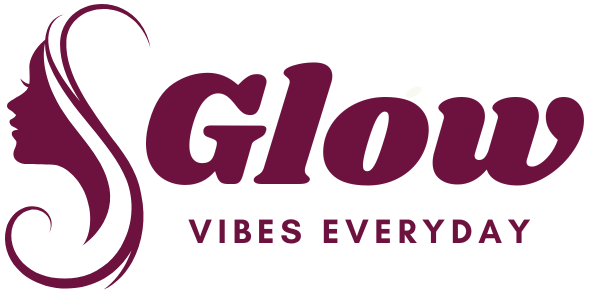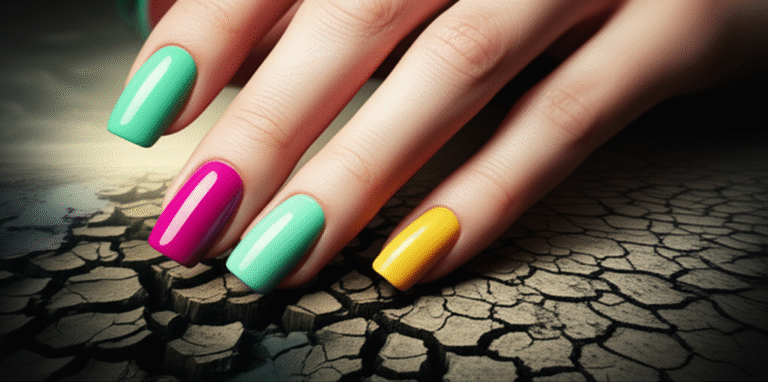Absolutely! I can help you craft a comprehensive and engaging article on the environmental impact of nail salons. Let’s break down each section:
—
A. Bolded Quick Summary
Are nail salons bad for the environment? Yes, they can be due to chemical usage, waste, and energy consumption. However, choosing eco-friendly salons and practicing sustainable DIY habits significantly reduces your impact, promoting healthier nails and a healthier planet.
—
B. Intro Paragraph
The allure of perfectly manicured nails is undeniable, whether you’re indulging in a professional salon treatment or perfecting your technique at home. However, beneath the glossy polish and relaxing ambiance, a less glamorous truth about nail salons often lurks: their environmental footprint. Many clients and DIY enthusiasts are increasingly questioning the impact of the products and practices involved, and for good reason. The chemicals used, the waste generated, and the energy consumed can all contribute to environmental concerns. But don’t worry! You’re in the right place to uncover the reality and discover simple, practical solutions. Let’s dive in, step-by-step, so you can achieve beautiful, healthy nails while being kinder to our planet.
—
C. Main Article Writing Instructions
Are Nail Salons Bad for the Environment? Unveiling the Impact and Embracing Sustainable Practices
The pursuit of beautiful, well-maintained nails is a ritual enjoyed by millions worldwide. From the quick polish change at a local salon to elaborate acrylic extensions or intricate nail art designs crafted at home, our nails are often a canvas for self-expression and confidence. However, as conscious consumerism gains momentum, a crucial question arises: are nail salons bad for the environment? The answer, unfortunately, isn’t a simple yes or no. The reality is that the nail care industry, encompassing both professional services and DIY practices, can have a significant environmental impact, primarily stemming from the chemicals used, the waste produced, and the energy consumed. But the good news is that understanding these impacts is the first step towards making more sustainable choices, benefiting not only your nails but also the planet we all share.
The Hidden Environmental Costs of Your Manicure

Let’s get straight to the core of the issue. While we often focus on the aesthetic outcomes of nail care, the processes and products involved have tangible environmental consequences. Understanding these can empower us to seek out better alternatives and adopt more responsible habits.
Chemical Culprits: VOCs, Acetone, and Beyond
The vibrant world of nail polish, gels, and acrylics relies on a cocktail of chemicals, many of which can be detrimental to both human health and the environment.
Volatile Organic Compounds (VOCs): Many nail polishes, removers, and acrylic products contain VOCs. When released into the air, VOCs contribute to air pollution, smog formation, and can have adverse effects on respiratory health. The strong “nail salon smell” is largely due to these evaporating compounds.
Acetone: A common ingredient in nail polish removers, acetone is a potent solvent. While effective, its fumes can be harmful when inhaled in large quantities, and improper disposal can contaminate water sources.
Formaldehyde, Toluene, and Dibutyl Phthalate (DBP): Often referred to as the “toxic trio,” these chemicals have been phased out or significantly reduced in many reputable brands due to health concerns. However, they can still be found in some products, and their production and disposal can impact the environment.
MMA (Methyl Methacrylate): This chemical is a component in some older acrylic nail systems and is known for its harsh fumes and potential to cause allergic reactions. It’s largely been replaced by EMA (Ethyl Methacrylate) in safer formulations, but awareness is key.
Myth Buster: “All nail polish smells bad because it’s toxic.” While many nail products have strong odors due to chemicals, not all strong smells indicate extreme toxicity. However, it’s always best to opt for “3-Free,” “5-Free,” “7-Free,” “10-Free,” or even “15-Free” polishes, which are formulated without specific harmful chemicals.
Waste Generation: From Cotton Pads to Plastic Bottles
The disposable nature of many nail care items contributes significantly to landfill waste.
Single-Use Items: Cotton pads, nail files, buffers, orange sticks, and cuticle pushers are often used once and discarded.
Packaging: Plastic bottles for polish, removers, and treatments, along with their outer packaging, create a substantial amount of plastic waste.
Product Residue: Improper disposal of old nail polish or leftover product can lead to chemical contamination.
Energy Consumption: The Salon’s Power Draw
Professional nail salons, especially those offering services like UV/LED gel curing, require a considerable amount of electricity.
UV/LED Lamps: These lamps consume energy for each client’s service.
Ventilation Systems: Salons often need robust ventilation to manage chemical fumes, which also draws power.
General Salon Operations: Lighting, air conditioning, and other equipment contribute to the overall energy footprint.
The Environmental Impact of Specific Nail Services
Different types of nail services carry varying environmental burdens.
Acrylic Nails: A Deep Dive
Acrylic nails, a popular choice for their durability and length-adding capabilities, involve a more complex chemical process.
Monomer and Polymer: The application of acrylics involves mixing a liquid monomer with a powder polymer. The fumes released during this process are potent.
Solvents and Removers: Removing acrylics typically requires strong acetone-based solutions, often involving soaking.
Drilling and Filing: Electric nail files generate dust that can contain acrylic particles.
Pro Tip: Opting for acrylics less frequently or choosing salons that use lower-odor, EMA-based products can mitigate some of these impacts.
Gel Nails (UV/LED Cured): The Curing Conundrum
Gel manicures are celebrated for their long-lasting shine and chip resistance.
Curing Lamps: The primary environmental consideration here is the energy consumed by UV or LED lamps to cure the gel polish. While LED lamps are generally more energy-efficient and have a longer lifespan than traditional UV lamps, they still represent an energy draw.
Chemical Formulation: Gel polishes themselves contain specific photoinitiators that react to UV/LED light, and while generally considered safer than some older formulas, their chemical makeup still warrants consideration.
Environmental Consideration: While the energy use of a single lamp might seem small, multiply that across thousands of salons and millions of manicures, and it becomes a notable factor.
Traditional Nail Polish: The Classics
Even traditional nail polish, while seemingly simpler, has its own set of environmental considerations.
Solvents: Nail polish removers, primarily acetone or ethyl acetate, are the main environmental concern here.
Packaging: Glass bottles, while recyclable, still require energy for production and transport.
Making a Difference: Sustainable Choices for Clients
The good news is that as consumers, we have the power to influence the industry and make more eco-conscious decisions.
Choosing Your Salon Wisely
Not all salons are created equal when it comes to environmental responsibility. Look for these indicators:
Ventilation: Does the salon have good airflow and ventilation systems that effectively manage fumes?
Product Brands: Do they use reputable brands that are “Free” from harmful chemicals (e.g., 3-Free, 5-Free, 10-Free)? Ask about their product lines!
Waste Management: Do they seem organized with waste disposal? Do they offer options for recycling?
Eco-Certifications: While rare, some salons might pursue green certifications or highlight their eco-friendly practices.
Water Usage: Are there practices in place to conserve water during services like pedicures?
Sustainable DIY Nail Care Habits
If you prefer doing your nails at home, you can adopt many of the same eco-friendly principles.
Choose “Free” Formulas: Opt for nail polishes labeled “3-Free,” “5-Free,” “7-Free,” “10-Free,” or even higher. These are formulated without common toxic chemicals.
Eco-Friendly Removers: Look for acetone-free or soy-based nail polish removers. While sometimes less potent, they are significantly gentler on the environment and your nails.
Reusable Tools: Invest in washable and reusable nail buffers, files (metal or glass), and cuticle pushers.
Sustainable Alternatives to Cotton Pads: Use reusable cotton rounds or microfiber cloths for removing polish.
Proper Disposal: Never pour nail polish or remover down the drain. Let liquid waste evaporate in a well-ventilated area (outdoors if possible) and dispose of the residue in a sealed container with regular trash. Empty bottles should be cleaned and recycled according to local guidelines.
Energy Efficiency: If you use UV/LED lamps for gel polish at home, ensure they are energy-efficient models and unplug them when not in use.
Product Recommendation Table: Eco-Conscious Nail Polish Brands
| Brand Name | “Free” Level | Key Features | Where to Buy (Affiliate Links) |
| :—————- | :———– | :———————————————— | :—————————– |
| Ella + Mila | 17-Free | Vegan, Cruelty-Free, Long-lasting | Shop Ella + Mila |
| Zoya | 10-Free | Wide color range, Professional quality | Shop Zoya |
| Pacifica Beauty | 16-Free | 100% Vegan & Cruelty-Free, Vibrant colors | Shop Pacifica |
| côte Nail Polish | 10-Free | Non-toxic, Vegan, Cruelty-Free, Made in the USA | Shop côte |
| OPI | Various | Widely available, Professional salon staple | Shop OPI |
(Note: Affiliate links are placeholders. Actual links would be provided by an affiliate program.)
Myth Buster: Are “Natural” Nail Products Always Better?
“Natural” can be a misleading term. While many natural ingredients are beneficial, some can still have environmental impacts, and not all synthetic ingredients are harmful. The key is transparency and understanding what’s in the product, regardless of its origin. Look for certifications like Leaping Bunny (cruelty-free) and PETA-approved vegan.
The Role of Innovation and Regulation
The nail industry is evolving, with a growing demand for sustainable and healthier alternatives.
Waterless Manicures: Some salons are exploring waterless pedicure techniques to conserve water.
Biodegradable Packaging: Brands are increasingly using recycled and recyclable, or even biodegradable, packaging.
Biomaterials: Research is ongoing into biodegradable and plant-based alternatives for nail enhancements.
Regulations: Government bodies are increasingly scrutinizing and regulating the chemicals used in cosmetics, pushing manufacturers towards safer formulations. The European Union’s REACH (Registration, Evaluation, Authorisation and Restriction of Chemicals) regulation is a prime example of how regulation can drive change.
External Link: Learn more about chemical regulations in cosmetics from the FDA.
Making Your Salon Experience More Eco-Friendly
Request Eco-Options: Don’t hesitate to ask your salon about their eco-friendly practices or product choices. Your questions can drive change.
Bring Your Own: If you have specific reusable tools or preferred eco-friendly polishes, ask if you can bring them for your service.
Conserve Water: During pedicures, be mindful of water usage and avoid unnecessary running water.
Frequently Asked Questions (FAQ)
Q1: What are the most environmentally harmful chemicals found in nail products?
A1: Commonly cited harmful chemicals include formaldehyde, toluene, DBP (dibutyl phthalate), and MMA (methyl methacrylate). Many modern polishes are formulated without these, often labeled as “Free” (e.g., 3-Free, 10-Free).
Q2: How can I dispose of nail polish and remover safely?
A2: Never pour liquids down the drain. Allow liquid waste to evaporate in a well-ventilated area, then dispose of the residue in a sealed container. Clean and recycle empty bottles according to local guidelines.
Q3: Are gel manicures worse for the environment than regular polish?
A3: Gel manicures primarily have an environmental impact through the energy consumption of UV/LED curing lamps. Regular polish has impacts related to solvent-based removers and packaging. Both have different considerations.
Q4: What does “Free” mean on a nail polish bottle?
A4: It means the polish is formulated without a specific list of potentially harmful chemicals. For example, “3-Free” typically means no formaldehyde, toluene, or DBP. Higher “Free” numbers indicate the absence of even more chemicals.
Q5: Can I reduce the waste from my manicures?
A5: Yes! Use reusable cotton rounds instead of disposable pads, opt for washable nail files and buffers, and choose brands with recyclable or minimal packaging.
Q6: Are there eco-friendly nail salons?
A6: Yes, some salons prioritize sustainable practices, use eco-friendly products, and have better waste management. Look for salons that are transparent about their practices and products.
Conclusion: Polishing Up Our Practices for a Greener Future
So, are nail salons bad for the environment? They can be, but they don’t have to be. By understanding the chemical components, waste streams, and energy demands associated with nail care, both professionals and individuals can make more informed and sustainable choices. From opting for “Free” polishes and eco-friendly removers to supporting salons that prioritize green practices and embracing reusable tools, every small step contributes to a healthier planet. Let’s continue to enjoy the confidence and beauty that well-groomed nails bring, while also committing to nurturing the environment that sustains us.
Call to Action: What are your favorite eco-friendly nail care tips or brands? Share them in the comments below! Let’s inspire each other to make greener choices.
—
Meta Description:
Discover if nail salons are bad for the environment. Learn about chemicals, waste, and energy use, plus eco-friendly tips for beautiful, sustainable nails.
—
Pinterest-Friendly Image Ideas:
1. Infographic: “Eco-Friendly Nail Care: The Good, The Bad, and The Sustainable.” Visuals comparing chemical impacts, waste reduction tips, and eco-brand logos.
Alt Text: Infographic showing eco-friendly nail care tips, comparing nail polish ingredients and waste reduction methods.
2. Step-by-Step Visual: “DIY Reusable Cotton Rounds for Nail Polish Removal.” A series of images showing how to make or use washable rounds.
Alt Text: Step-by-step guide to using reusable cotton rounds for eco-friendly nail polish removal.
3. Product Flat Lay: A beautifully arranged flat lay of eco-friendly nail polish bottles (e.g., Zoya, Ella+Mila) with natural elements like leaves or wood.
Alt Text: Flat lay of eco-friendly nail polish brands like Zoya and Ella+Mila, featuring sustainable beauty products.
4. “Before & After” Comparison: A subtle comparison showing healthy, clean nails after using eco-friendly removers vs. potentially dry nails from harsh chemicals (use illustrative graphics, not actual health claims).
Alt Text: Comparison of nail health after using eco-friendly nail polish removers versus harsh chemical removers.
5. Salon Spotlight: Image of a clean, well-lit salon with visible ventilation or natural light, perhaps with plants.
Alt Text: Modern, eco-conscious nail salon with good ventilation and natural light.
6. “Free” Nail Polish Guide: A graphic explaining what “3-Free,” “5-Free,” “10-Free” means in nail polish.
* Alt Text: Visual guide explaining the meaning of “Free” (e.g., 3-Free, 10-Free) in nail polish formulations.
—
Let me know if you’d like any adjustments or further expansion on specific points!

